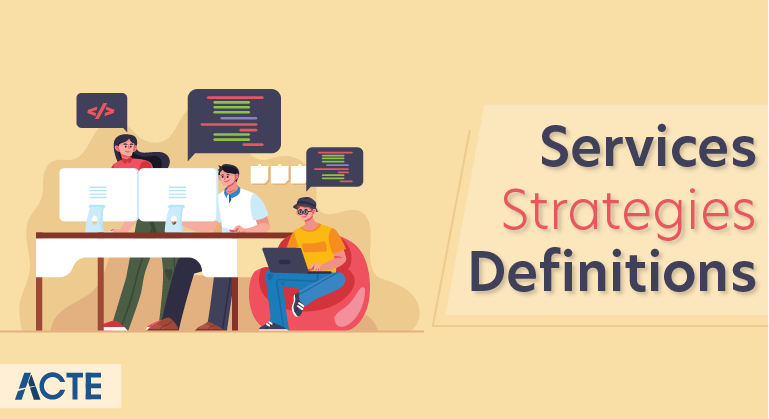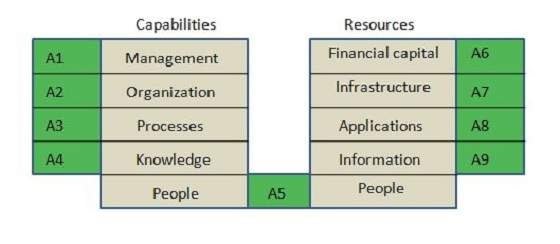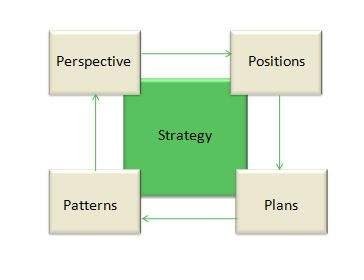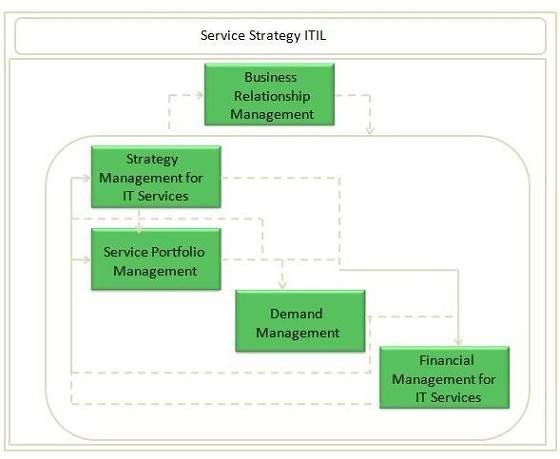
What Is Service Strategy?
- The marketing strategy of service industry focuses on delivering experiences processes and other intangible is to the customers and not physical goods like product industry. It also involves a focus on all functions equally.
- Role of the functions of a company like selling, marketing, operations, human resources, and other functions must work efficiently and together in order to create an excellent service strategy.
- A service strategy is more customer-centric and is centered on the usage of customers and their relationships.
- Many of the service sectors such as hospitality healthcare transportation our offerings of themselves and also the primary revenue-generating activities of the respective companies.
- Service industries categorized into another category which is called customer service which includes providing technical support for the product of the company to the customers and assisting the customer with any technicalities required.
- Customer services a segment of an organization which does not produce revenue but rather is a form of a troubleshooting service which provides answers and solutions to the queries of the customers. Services can also be considered as a value addition for the company.
- In case of services, there is a requirement of 7 P’s of marketing instead of 4 Ps of marketing which is product place price promotion people process and physical evidence since 4 P’s are not enough to describe the intricacies of services marketing. Because unlike a product, services are produced and consumed at the same time.
- The company should also take care of their employees and personal appearance and all other small factors which influence the perceptions of the customers towards the service. there should also be an effective calculation of the service so as to be on par with the industry standards. There is often a gap between the perception of the company and the expectations of the customer.
- The companies of an strive to device a service strategy in such a way that the gap is minimum. The wider the gap more difficult it will be for the company to sustain in the market. The strategies used by the organizations vary on the nature of the offering and the business.
- However, service strategy should be formed in such a way that it satisfies the customer expectations or comes closest to it. the success of a company is measured in terms of the service that they provide which is why it is crucial for organizations to not run the make good products but also provide an excellent service.
- Companies which are exclusive in service industries like hotel business or hospitality or entertainment should constantly upgrade themselves and should modify their offerings in order to meet the change in demand from the customers. However, there are companies which are both into the offerings of the product as with the service for example companies like Dell and Apple.
- Both of these companies provide products which are electronics and they also provide after Sales service. In both of them, Apple stands out as the best because of efficient after sales service.
Importance Of Service Strategy
Service Strategy
It is very important in a highly competitive business environment that there is a service strategy present in order to address customer needs and wants. Following are a few of the reasons which elaborate on the importance of service strategy:
- The cost of getting a new customer is much more than entering the retention of the existing customers. The customer strategy for service strategy should be in sync with the marketing strategy of the company.
- It is a well-known fact that to get a new customer the cost would be 5 to 10 times more than that of the cost of retaining a current customer.
- More often than not customers are lost because of poor services and bad treatment which gives them unsatisfactory. It is also estimated that an unhappy customer will talk about his dissatisfaction to at least 8 to 16 other potential customers.
- Adding social media and that the satisfied customer’s voice will reach 1600 more people which is why customer retention is of crucial importance to the organization.
- Looking on the other side of service strategy a customer who is satisfied or who is loyal will cost not even a single penny but will add value to the business by being word-of-mouth ambassador.
- This will save millions of bucks of the company since it is free publicity from the customer to a potential customer. This is the reason why every customer should be satisfied with the service strategy.
- It is also stated that customer loyalty can have any impact on the business. Making the customer is important creates all customers and those all customers will continue to do business in spite of increasing competition.
- Higher customer loyalty translates into higher customer retention and better competitive advantage.
- Companies should ensure that the service strategy is in sync with the vision and mission of the organization. They should complement the strategy of the organization.
- Companies to take time in order to develop and implement an efficient service strategy which will be responsible for the retention of the existing customers.
7 Steps To Create An Efficient Service Strategy :
In most of the cases, the Service strategy depends on the nature of the business but here are the following steps which can generally be used and implemented by most of the service organizations.
Crafting A Service Vision :
- The primary step is to communicate the vision of the service to the employees associated with the business.
- The employees associated with the organization should understand and comprehend the organizational goals and the vision of the organization and should be able to write their responsibility to help the company achieve that vision.
Contemplating The Customer Needs :
- More often than not the companies fail and waste their valuable resources in creating services of product that the company thought customers would want only to know that the offering was not what the customers wanted at all.
- The important part is to know what the customer needs and to put it in sync with the organization’s vision and mission. Taking the feedback of customers is the first step in order to know and determine what their expectations are so that the company can form a strategy around the feedback obtained in order to deliver and meet the expectations of customers.
- The market needs for customer needs can be assessed using a method such as satisfaction surveys for focus groups and the customer feedback forms. Development of such feedback forms and questionnaires is very important and should focus on the questions that need to be answered by the customers.
- It is also very important to keep in mind that the needs of customers keep on changing with time and are like a moving target. Since it constantly keeps changing it is very important for the companies to form a process which will continuously keep on updating them about the changing needs of the customer so that the companies can prepare and modify themselves and their offerings accordingly.
Right Hiring :
- When it comes to facing the customers it is not the company who is going to face them rather it is the employees who are going to face the customers. Employees are the face of the organization and organization has to ensure that the face is represented correctly.
- The employees should have the right skill set which meets the goals of the organization and helps to form a strong network and backbone to provide service to the customers.
- Having a right attitude and personality is something which companies cannot develop in the employees which is why they should take care of these things with hearing.
- Most of the things can be incepted and developed in the employees but most of the other things have to be built in. Interacting with customers and providing services is an art more than science and not everyone can achieve it.
Goal setting for the service team :
- Wednesday identification of customer needs and the parameters for customer satisfaction is done then the organizations have to create goals for the service team in order to achieve customer satisfaction.
- These goals should be measurable and quantifiable so that the organization can grow the employees as well as along with the growth of the business.
- The employees should be able to understand the vision and mission and the target of the organization so that they can align themselves to reach chief and exceed those objectives. An example of customer satisfaction can be given as follows:
- The service team of a refrigerator company provides after sales service. Once the customer causes about the breakdown of the machine the time taken by the service team to reach the place of the customer and correct the machine is measured.
- The lesser the time to attend the customer breakdown calls the higher would be the customer satisfaction. This can be a measurable parameter in order to appraise the employees.
Constant Training And Development :
- Once the hiring is done in a proper and correct way the employees will have some inborn cause it is which the organization will be able to utilize them in order to serve the customers correctly.
- The other part of having a good service team is providing them with constant training in order to upgrade their technical skills.
- The training should focus not only on technical skills but also on interacting with customers. Right service strategy requires suitable training to the service team so that not only the customer but also your organization benefit from it.
- The employees need to know about the goals of the organization so that they can modify themselves to fit accordingly. The need to be trained not only on the technical skills but also on other soft skills like answering the customer phone calls and customer complaints and providing services.
Accountability :
- Organizations should ensure that the employees have a suitable understanding of the importance of good customer service and how their actions affect the organization’s performance overall.
- The organizations should also ensure that the employees are held accountable in order to achieve the service goals.
- This also forms the part of the performance management system and should be embedded in the culture of the company.
- For example, rewarding the employee with the highest customer satisfaction and working on the employee with over customer satisfaction.
Awards and recognitions :
- Positive reinforcement always works in every organization which is why it is very important to recognize the performing employees who are responsible for excellent customer service. This will help the other employees to perform well and live up to the set goals or exceed them.
- This also reinforces the vision and mission of the organization and the service strategy which is chalked out for everyone. A successful organization is categorized by strong customer service.
- Service Strategy helps to design, develop and implement service management as organizational capabilities and strategic assets as well. It enables a service provider to consistently outperform competitive alternatives over time, across business cycles, industry disruptions and changes in leadership.

Service strategy comprises of the following key concepts :
- Value creation
- Service Assets
- Service Provider types
- Service structures
- Defining the service market
- Developing service offerings
- Financial management
- Service portfolios
- Demand management
- Return on investment
Strategic Assessment :
Before crafting service strategy, a provider should first take a careful look at what it does already.The following questions can help expose a service provider’s distinctive capabilities :
- Which or our services or service verities are the most distinctive?
- Which or our services or service verities are the most profitable?
- Which of our activities in our value chain or value network are the most different and effective?
Factors In Strategic Assessment
Here are the key factors that play important role in strategic assessment:
| Strategic Assessment | Description |
|---|---|
| Strengths and weaknesses | The attributes of the organization. For example resources and capabilities, service quality, skills, cost structures,product knowledge, customer relationship etc. |
| Business Strategy | The perspective, position, plans and patterns are received from a business strategy. |
| Critical Success factors | How will the service provider know when it is successful? |
| Threats and opportunities | Includes competitive thinking. For example, is the service provider vulnerable to substitution?, or Is there a means to outperform competing alternatives? |
Value Creation : Service strategy defines a unique approach for delivering better value. According to customers service consist of two elements :
- Utility
- Warranty
Utility : Utility is perceived by the customer from the attributes of the service that have positive effect on the performance of task associated with the desired business outcomes. This is fir for purpose.
Utility is generally stated in terms of :
- Outcomes supported
- Ownership costs and risks avoided
Warranty : Warranty ensures the utility of the service is available as needed with sufficient capacity, continuity, and security. Value of warranty is communicated in terms of level of certainty.Warranty is usually defined in terms of availability, capacity, continuity, and security of the utilization of the services.
Availability : It assures the customer that the services will be available for use under agreed terms and conditions.
Capacity : It assures that the service will support a specified level of business activity or demand at a specified level.
Continuity : It assures that the service will continue to support the business through major failures.
Security : It assures that the service provided by the service provider will be secure.
Service Assets :There are two types of service assets as listed below :
- Resources
- Capabilities
Resources : Resources are the inputs for production. The resources are transformed by management, organization, people and knowledge.
Capabilities : Capabilities refer to skills to develop and control the resources for production. The skills are based on knowledge, experience and information.

Service Provider Types
Service Provider can be broadly classified into three types as listed below :
- Type I – Internal Service Provider
- Type II – Shared Service Provider
- Type III – External Service Provider
Type I Internal Service Provider
Internal Service provider refers to the business functions within an organization. Administration, finance, human resources, and IT service providers all comes under internal service providers.
Type II Shared Service Provider
In this, business functions such as IT, human resources, and logistics are consolidated into an autonomous special unit called a Shared Service Unit (SSU).
Type III External Service Provider
External service provider refers to the third party service providers. It can offer competitive prices and drive down unit cost by consolidating demand.
The Four Ps of strategy :
The below mentioned Four Ps identify the different forms of a service strategy and are considered as entry points to service strategy.

Perspective : It describes a vision & direction and articulates the business philosophy of interacting with customer.
Positions : It describes the decision to adopt a well defined stance. It is expressed as distinctiveness in minds of customers. This means competing in the same space as others but with differentiated value proposition that is attractive to the customer. Whether it is about offering a wide range of services to a particular type of customer or being the lowest cost option, it is a strategic position.
Plan : A plan describes “How do we offer high value or low cost services?” or “How do we achieve and offer our specialized services?”
Pattern : It describes the organization’s fundamental way of doing things.
Services strategy processes :
The following diagram expresses the different processes and their relationship in service strategy .

Strategy Management : This process involves four activities − definition of market, development of offering, development of strategic assets, and preparation for the implementation of the strategy.
Service Portfolio Management : Service portfolio defines all services that a service provider can provide. It helps to control service management investments throughout an enterprise and actively managing their value.
Business Relationship Management : This process deals with establishing good relationship between service provider and customers by ensuring that appropriate services are developed to meet customer’s needs.
Demand Management : This process maintains balance between consumption of services and their delivery.
Financial Management : Financial management helps to determine all the costs of IT organization. It can serve as a strategic tool for all three kinds on service provider types − internal, external and shared service provider.
There are several roles that are responsible for managing different key aspects of Service Strategy. This chapter discusses the roles of each in detail.
| Role | Responsibility |
|---|---|
| Business Relationship Manager Maintains | Business Relationship Manager Maintains good relationship with customers Identifies customer’s needs Ensures service provider meet customer’s need Works closely with Service Level Manager |
| Manager | Demand Manager Responsible for understanding, anticipating, and influencing customer demand for services Works with capacity manager to ensure that service provider has sufficient capacity to meet the required demand |
| Financial Manager | Financial Manager Responsible for accounting, budgeting, and charging requirements |
| IT Steering Group | IT Steering Group (ISG)Sets direction and strategy for IT services Reviews the business and IT strategies in order to make sure that they are aligned Sets priorities of service development programs |
| Service Portfolio Manager | Service Portfolio Manager Decides on a strategy to serve customers in cooperation with ISG Develops service provider’s offering and capabilities |
| Service Strategy Manager | Service Strategy Manager Works with ISG in producing and maintaining the service provider’s strategy Responsible for communicating and implementing service strategy |






